Halls of Hegra is a solitaire wargame by Petter Schanke Olsen, published by Tompet Games. You play as the Commander of Norwegian volunteers defending the abandoned Hegra Fortress against German invaders in early WW2. Will you have what it takes to maintain morale and survive the siege?
April 9, 1940 – Mobilisation
The day dawned with chilling news: German forces had invaded Norway. We were hastily mobilized, our unit assigned to the formidable Hegra Fortress. We scrambled to prepare, digging old equipment from the snow and readying our defenses. Comrades joined from nearby villages. The air buzzes with a mix of fear and resolve.
Despite the uncertainty, there’s a strong sense of camaraderie. We’re ready to defend our homeland!
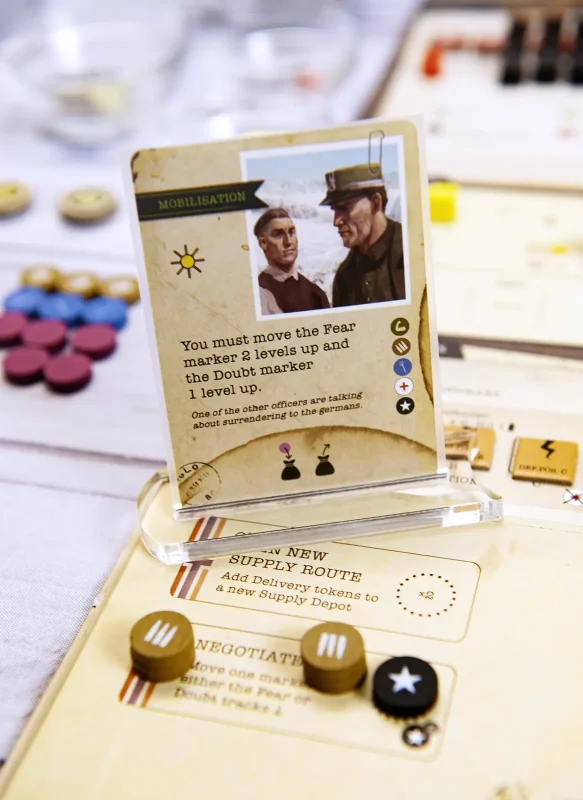
Game Overview
Halls of Hegra Theme
The box cover art sets you amongst Norwegian soldiers huddled behind a low stone barrier, facing the advancing German infantry. The landscape is blanketed in snow, with distant glimpses of artillery and airships. The scene is muted with whites and grays, creating a somber ambiance.
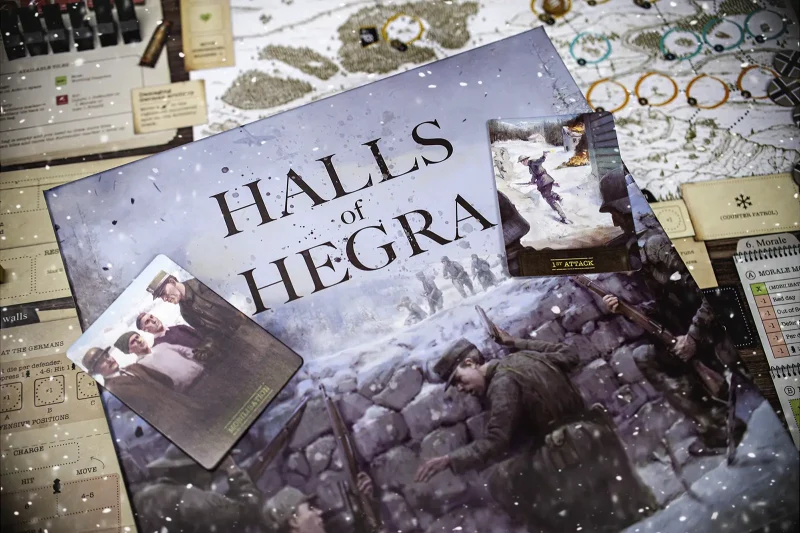
The game features artwork by Jog Brogzin and Joeri Lefevre. Each of the 5 Event card decks and both the High and Low Morale decks feature unique art on their backs, while the fronts of the Event cards display more images on the front (you can see many images in fuller detail in the back of the rulebook). The gameboard has sepia-toned sketches scattered in various places, particularly the Supply Run section which covers a third of the board.
Halls of Hegra Components
The box is the perfect size for the game, but I plan to print out this 3d insert I found on BGG to get optimal setup. A proper insert will reduce setup times considerably and help keep things organized.
I love the game board! It’s designed very well, with a sprawling Supply Run section taking up a third of the board, where you’ll send recruits on desperate dashes to get much-needed supplies while dodging or fighting German troops.
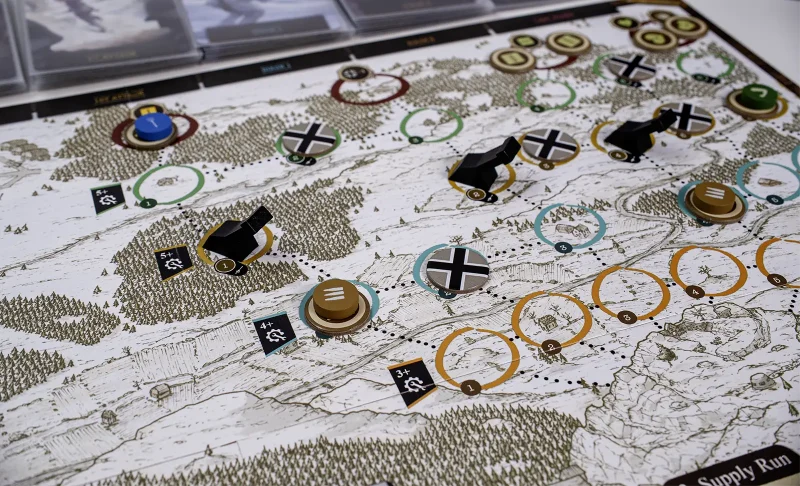
An Infirmary section with three beds and a waiting area shows the injured’s Relapse and Recovery conditions.
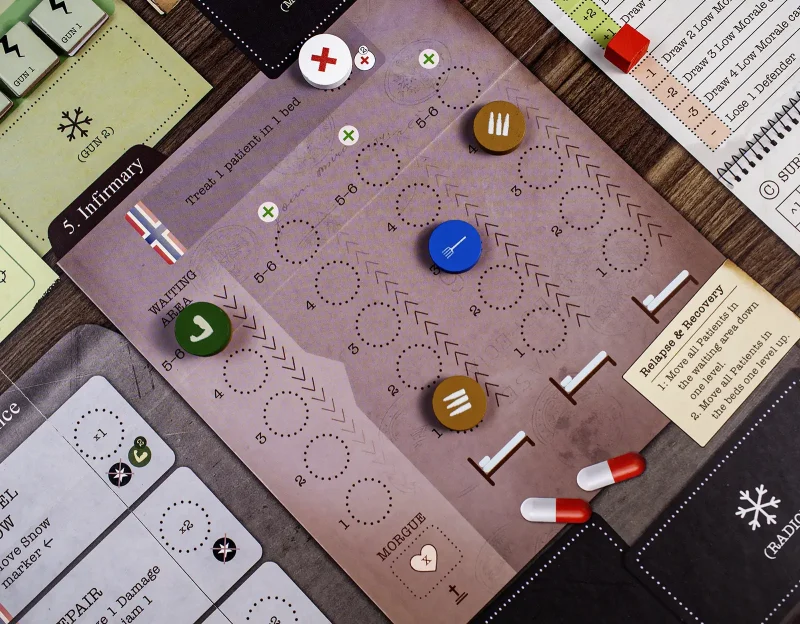
The Weather can change daily, and you’ll face its consequences on supply runs and shoveling snow to dig out equipment.

The modular section in the lower left first tracks Fear and Doubt for your gaining and retaining your recruits and then progresses to German Infantry attacks. Every section is well thought out and intuitive.
The components of the game are perfect for their purposes. The recruits are small screenprinted wooden discs of various colors. I wouldn’t want anything else, as they need to be placed on their worker placement spots (or in the infirmary), and you’ll want to stack them. German Infantry soldiers and Artillery are wooden black meeples. Red status and yellow supply cubes add a dash of bright color to a muted palette. The rest of the components you’ll work with are various chits depicting the supply run items, Hit bag tiles, equipment, and statuses.

The rulebook is 32 pages with informative illustrations and descriptions, ending with a few pages of informative Historical Background. The main sections cover the 3 phases of the game – Event, Morning and Day phases.
April 15, 1940 – First Attack
Today, the Germans launched their first ground assault. We witnessed infantry advancing under the cover of artillery fire, the shells thundering against our walls. Their numbers were greater, but our knowledge of the terrain and the fortress’s defenses gave us the upper hand. We repelled their assault with fierce resolve. The echo of gunfire still rings in my ears.
The sight of young soldiers, brave and scared, standing their ground will stay with me forever. Tonight, we stand vigilant, knowing this is just the beginning.
Halls of Hegra Game Objective
To win, play through 11 days and survive the Last Stand at the end of the last day with enough Healthy Defenders.
Several conditions will contribute to a loss. At the end of each day, you’ll do Morale and Surrender Checks, moving the Surrender tracker up or down on the bottom right corner of the gameboard. Too many Defenders in the Morgue/Waiting area or all 6 German artillery on the map can bump up the Surrender tracker. You’ll lose immediately if the tracker moves onto the Skull icon for Unconditional Surrender. But if you make it to Day 11 and have as many healthy defenders left after Last Stand as the Surrender marker level requires, you win!
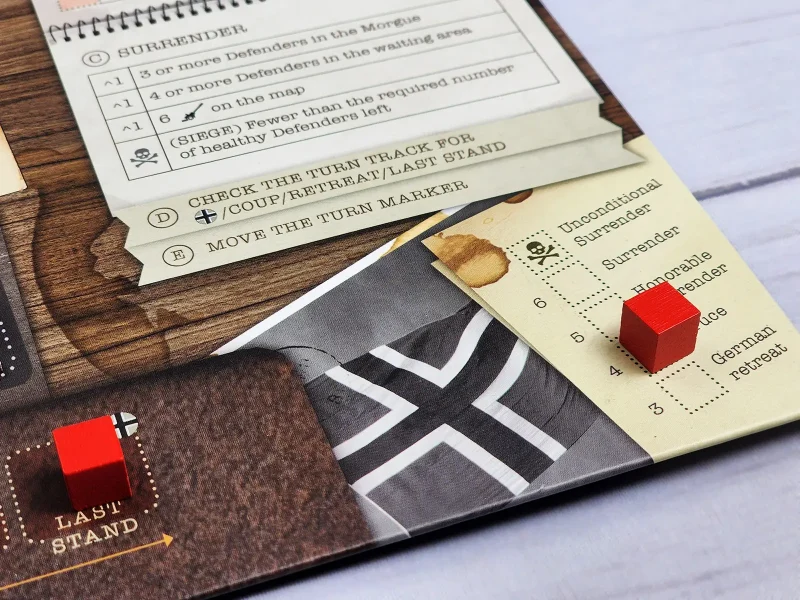
Gameplay
Each day, you’ll be engaged in various tasks to prepare and defend, all while managing the morale and despair of your troops. The game is divided into three stages comprising a total of 11 days:
- Mobilization (Days 1-3): Gain recruits, get supply routes going, prepare defenses, shovel snow and repair equipment!
- 1st Attack (Days 4-6): The village below Hegra Fortress is attacked. Defend it while making final preparations for the siege. Keep the supply runs going.
- Sieges 1 and 2 (Days 7-11): Endure relentless air bombing and infantry attacks while maintaining morale.

Each of the 11 days consists of three phases:
- Event Phase – Draw and resolve card events for that stage. During 1st Attack and Siege, you’re attacked by the enemy.
- Morning Phase – Supplies are divided amongst your Defenders to send on different action spaces.
- Day Phase – Each action space is resolved. Lastly, Morale and surrender checks are made.
April 22, 1940 – Siege
We’ve been engaging in sporadic skirmishes for days now. The Germans seem intent on taking Hegra, but we are equally determined to hold our ground. Supplies are holding for now, but we know this could be a prolonged siege. I volunteered for a supply run under the cover of night – a perilous but necessary task. Each day brings more shelling and sporadic infantry attacks. We’ve been tirelessly repairing equipment and fortifying positions. The siege is taking its toll. Injuries are common, and the infirmary is a sobering sight.
Yet, in this hardship, there’s unity. Our resolve is hardened; this fortress is more than walls and guns—it symbolizes our defiance.
Mechanisms
Halls of Hegra is a solo-only worker placement survival wargame. Each day, you’ll have a certain number of recruits to place around the gameboard to do specific tasks. There are different types of recruits – Officer, Soldiers, Volunteers, Hunters and Medics. Each type has a job it will excel in and other jobs it cannot or cannot do well.

Push your Luck
During the Mobilisation Stage, the focus is recruiting Defenders and reducing Doubt and Fear. The starting bag includes 1 Doubt disc, 6 Soldiers, 6 Volunteers, 3 Hunters, and 3 Medics. After resolving the Event card, another Doubt disc is added each day. On the first day, a second Doubt is added to the bag, providing the best opportunity for recruiting Defenders. Drawing Doubt limits recruitment to 1 Defender per round, with any other Defenders drawn going to the Reserve, most likely never to be seen again. Volunteers come with Supply tokens.

Worker Placement Areas
Then you’ll place the Recruits! During the Day, your recruits will go in this order.
- Defend the Walls – actions here will change depending on the phase of the war, but here, you’ll make sure to prepare your defenses and have enough recruits for the future.
- Fire Artillery – If you have guns ready to go, you can place 2 Soldiers or 1 Soldier and the Officer here to fire at your choice of target. There is only one spot here, but it will be essential to success!
- Supply Run – This large area shows how your recruits will move across the landscape to reach valuable supplies such as a Supply container, Morale, Miss tokens and more.
- Maintenance – Here, you’ll place recruits to Shovel Snow to gain valuable equipment and resources, Repair broken equipment, Bolster defenses and more.
- Infirmary – As recruits are injured, they are placed in varying conditions in three beds, the waiting room, or the Morgue.
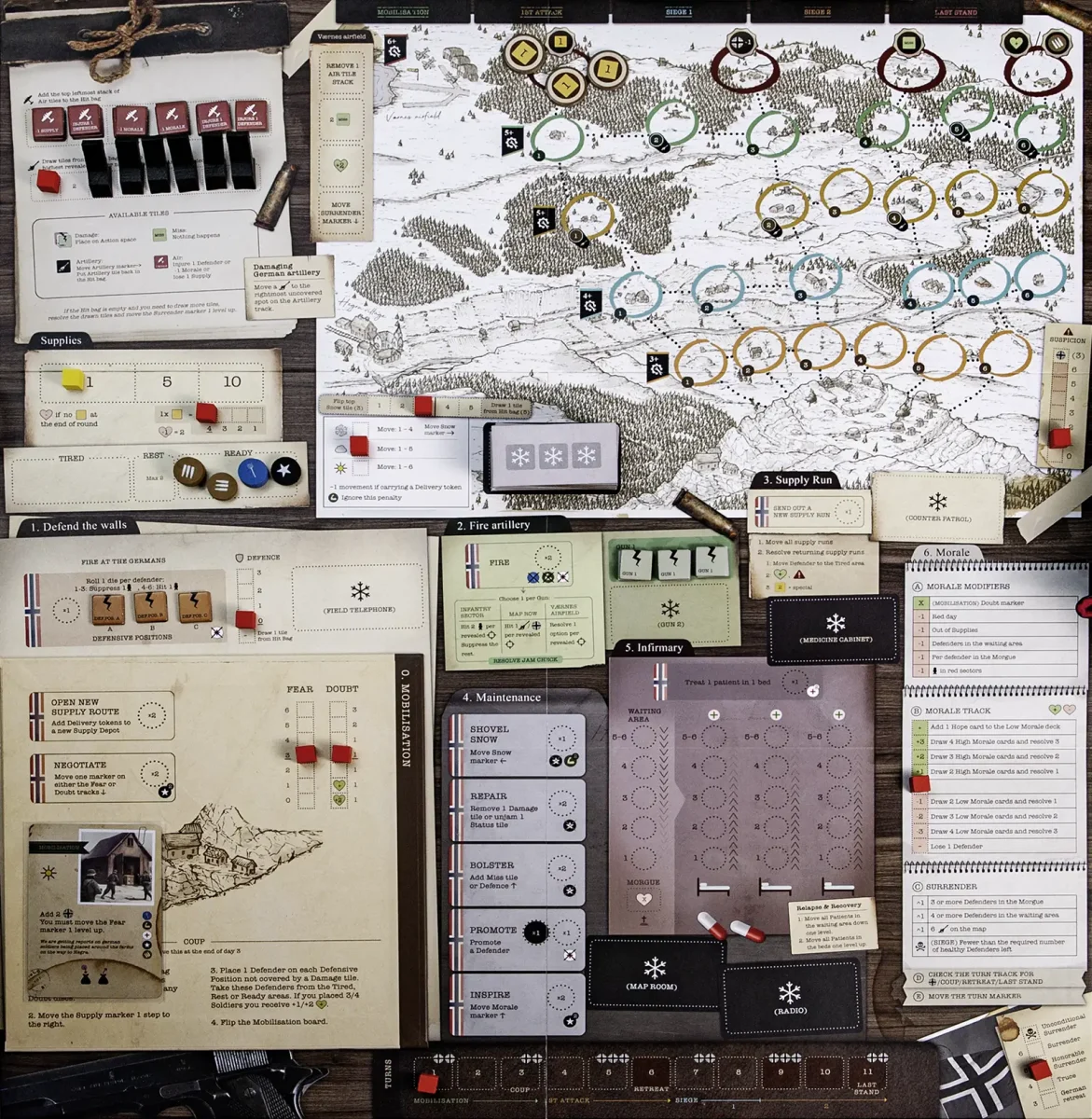
The way each of these sections is done is elegant. I briefly described a few sections in the Components section.
Be prepared to repair and unjam these guns.

Bag Building
In addition to your Recruit bag, you’ll build the Hit Bag, whether willingly or unwillingly, throughout the game. This bag won’t be used until the Siege stages, where you’ll add more Air Tiles and then draw tiles to determine what is hit.

You can start adding Miss tiles from Day 1. You want the airstrikes to Miss and not hit your equipment or men. While you start with only one Miss tile and one Artillery tile, this bag will fill quickly as you add more Air Tiles and repair equipment each turn. You’ll want to place as many Miss tokens here as possible, and you can do this through High Morale cards or having recruits increase them.
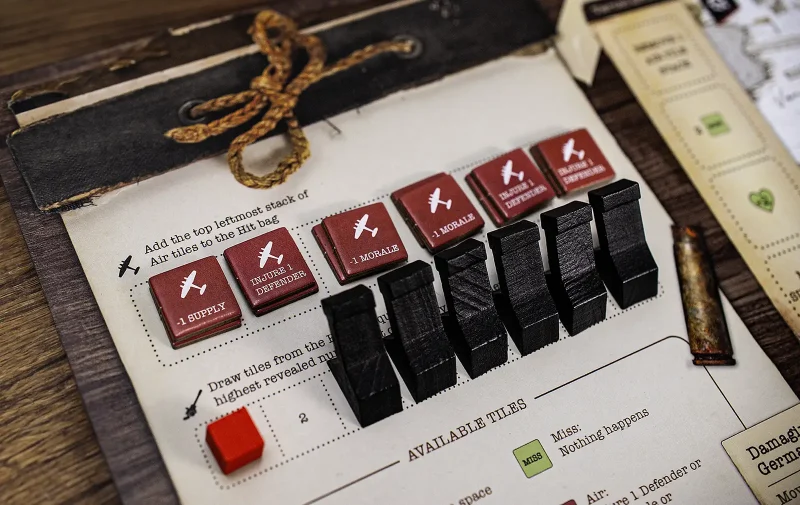
Dice Rolling

Five dice come with the game. Dice rolls determine the following:
- German Infantry Attacks – Dice determines whether the advancing Germans hit, advance, grenade, or stay put.
- Defender Injury severity – When Defenders are injured, you roll one die. Depending on the number, you’ll place this injured Defender in the Infirmary in an available bed. Lower numbers mean more severe injuries.
- Artillery Gun Jams – You have 3 main places to turn the Artillery gun, and after you fire a gun, you’ll roll a dice and compare it to the hit criteria in the targeted section to see if that gun jams.
- Fire at the Germans – Per Defender in Defensive positions, roll the die. 1-3 is a Miss, and you Suppress 1 German Infantry meeple. 4-5 is a Hit, and you can remove 1 German Infantry meeple to the Reserve.
- Machine Gun – A 1-3 roll suppresses up to 3 German Infantry meeples, with a 4+ removing 3 from the board.
- Supply Run – For German encounters, roll the dice to determine a Sneak or Fight success.

Pickup and Deliver
This mechanism will have you sending out recruits across the countryside to get badly needed supplies. Five Supply Depots are in the Supply Run section, each taking 5-6 spaces to reach. On snowy days, they can only run up to 4 spaces. Cloudy days: 5 spaces, with Sunny Days up to 6 spaces. Once they reach the Supply Depot, they stop. The next day, they can return, but while carrying a Supply, they are slowed by one space. So, on a Snowy Day, they could only move 3 spaces to return to the Fortress. Hunters are not slowed.
Once at the Fortress, you benefit from that supply (1 Supply, 1 Miss, Remove 1 German Patrol, 1 Morale, or 1 Soldier), plus 2 extra Supplies and 1 Morale. You’ll have to raise suspicion by one.
It’s possible to encounter 1 or more German Patrol tokens or German Artillery, in which case you’ll have to decide whether to Stop, Sneak or Fight. Sneaking and Fighting will require a dice check based on the current Suspicion level. Only Soldiers can Fight.
Tower Defense
The Siege stages will have an increasing number of German Infantry attacking. The removable board shows Siege 1 and the gameboard itself shows Siege 2. As described above, dice will determine their actions.

The German infantry attacks before you can.
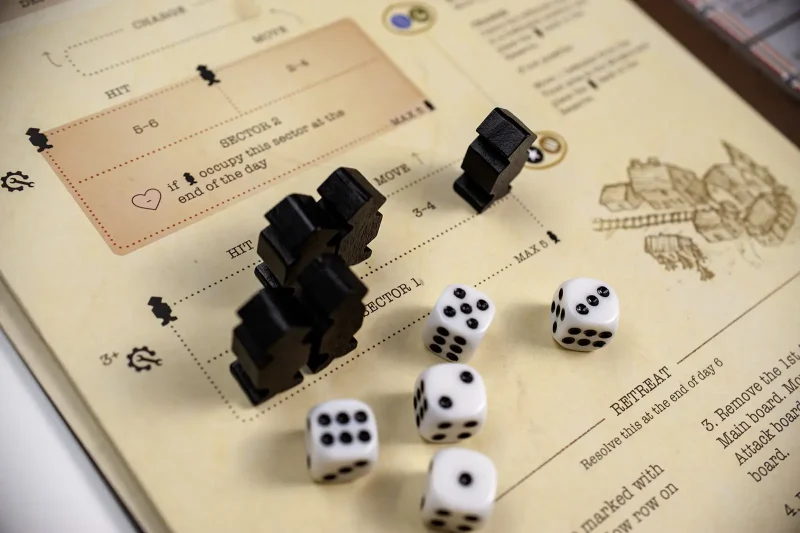

Keep 4 Defenders on the wall and the Defense up to 3! Defenders have different reaches, with Volunteers only able to hit the closest, Hunters able to hit a bit further, and Soldiers and Officer hitting any distance.

Solo Gameplay Experience of Halls of Hegra
I knew Halls of Hegra would be a challenging game – it’s been compared to Robinson Crusoe, another survival game. I love challenging survival games for both board and video games. I went in knowing that a win would be difficult to pull off, and eventually discovered the Easy setup and was able to win a few. In Easy mode, you set one or two events back a day to give you more time to prepare for each phase.
A true win on normal mode proved elusive. But I was determined, and finally, on my 11th play, I was able to win a normal game!
Be flexible and adapt to what you are given. Watch your defenses, repairs, and keep some people on supply runs. Soldiers can be added to supply runs to help reduce Suspicion on some turns or Fight excess enemies on others. Try new things! When I switched up my gameplay, I won my first game.
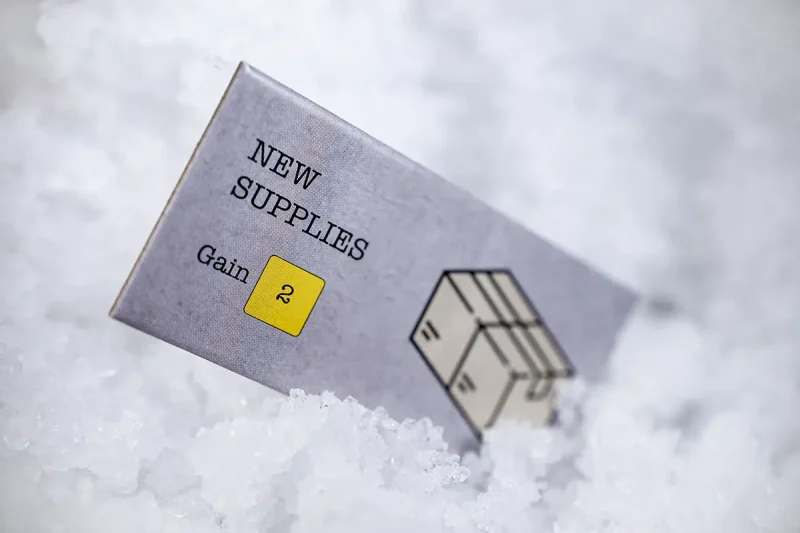
Footprint
You will need enough room on your table to fit the gameboard, the Reserve tokens/cubes, the Event and Morale cards, draw bags and a place to roll dice. This takes a minimum of 30″ wide and 30″ deep, making this fit comfortably in a Medium Footprint.
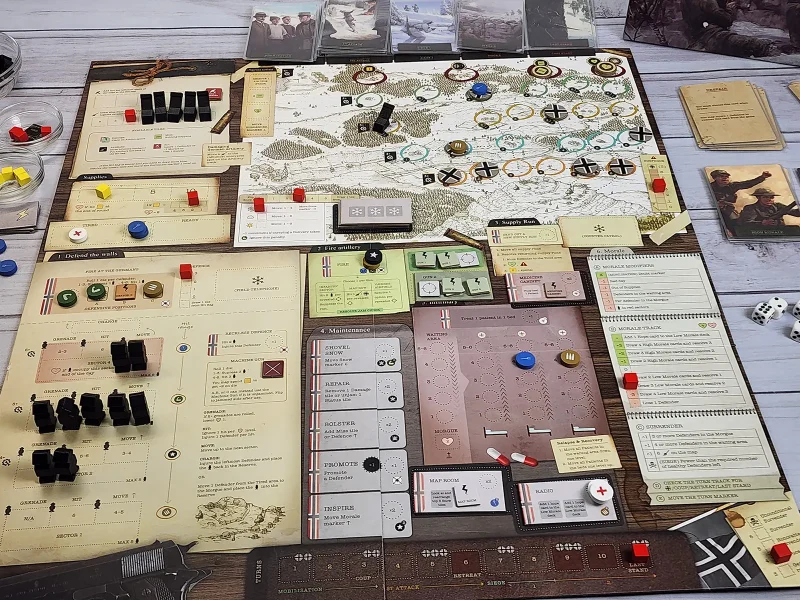
Time to Play
A fresh setup should take 8-9 minutes, with a repeat setup taking 5-7 minutes. Most of your time will be spent shuffling the card decks and placing them, setting up the recruits and placing 11 red status cubes on the board.
A game can take approximately 60-90 minutes. Teardown will take about 5-6 minutes.
Of course, repeated play can lower these times, and a functional insert can work wonders in saving time and organization.
April 30, 1940 – Siege Continues
The relentless siege continues. The weather fluctuates between heavy snowfalls and piercing cold winds, adding to our challenges.
Our supplies are dwindling, and we’ve had to ration food and ammunition. The German artillery hasn’t let up, and the air raids are more intense, reminding us of our precarious position. The infirmary is full, yet the injured are stoic, often asking about the front lines. Morale is a rollercoaster – moments of hope are quickly shadowed by despair. But we cling to our duty, to each other.
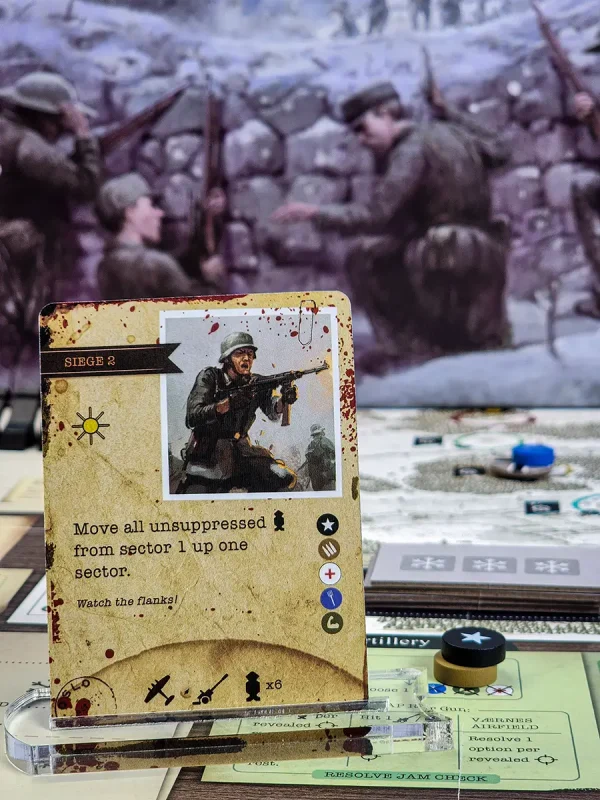
Replay Value
Each game will be a different experience. The five main Stages each have 11-12 cards that determine the weather, events, and amount of infantry for that day, with each phase lasting about three days.
Depending on various factors from Event cards and uncovered Equipment/supplies from shoveling snow add to a different game each time. You can adjust your gameplay for added difficulty or ease. Add Advanced Event cards and a Mission to add even more depth and complexity to your game when you’re ready.
I will keep this game in my collection and can see myself returning to play in years to come.
Halls of Hegra Pros and Cons
Pros
- Super thematic experience – you simulate what the Norwegian soldiers went through for every step.
- The game offers ways to adjust the difficulty, which is always nice for a challenging game such as Halls of Hegra.
- There are many strategies to explore and lots of replayability.
Cons
- The odds are stacked against you. If you don’t like games where wins are scarce, you may not like this.
- There is quite a lot of luck involved.
- The theme is bleak, and some people may not enjoy it.
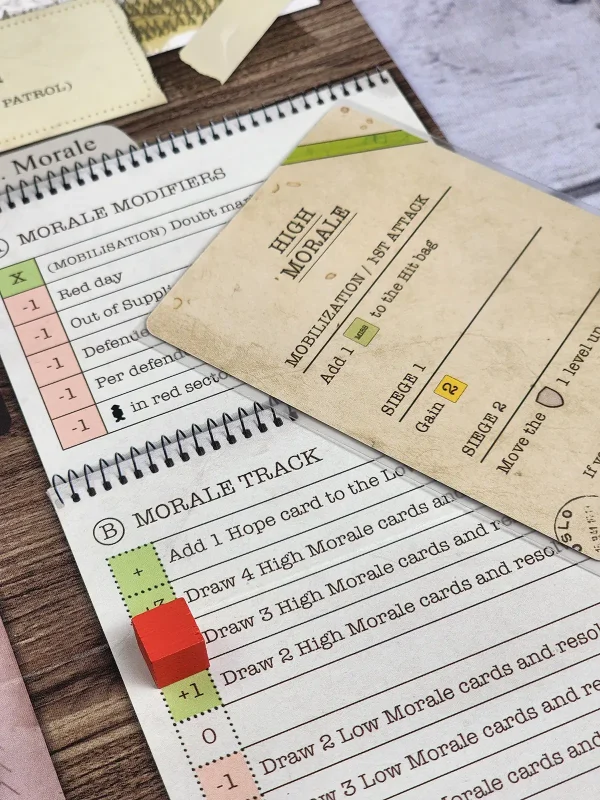
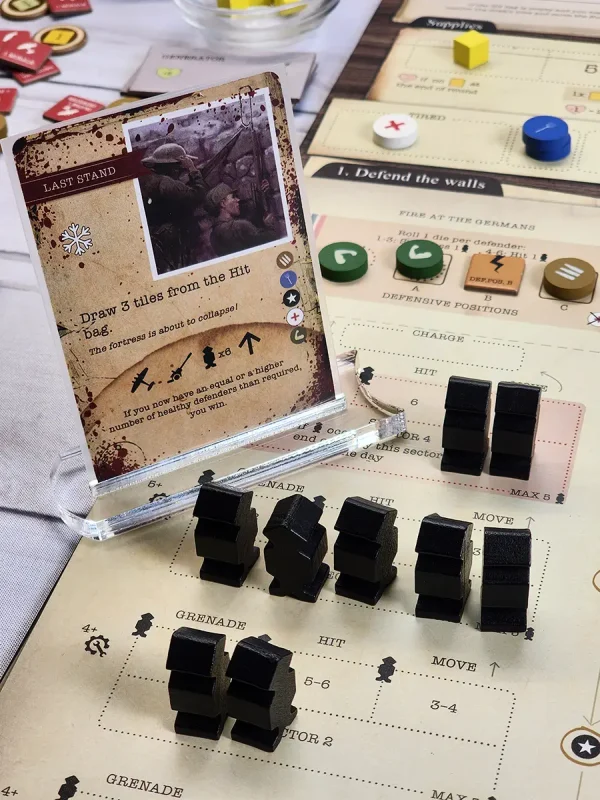
May 5, 1940 – The Last Stand
Supplies are at their end, and the enemy is tightening their grip. We’ve endured countless attacks, artillery barrages, and the relentless cold. The fortress, battered yet standing, has become a symbol of our resistance. Our numbers are reduced, and injuries are mounting, but the spirit of defiance burns brighter than ever.
Today, we prepare for our final confrontation. We’re exhausted, yet there’s a sense of pride and a determination to fight to the last. For Norway, for freedom, we stand united.
Halls of Hegra – Final Thoughts
This was my first “wargame”! To prepare myself, I watched the 3-part playthrough of Totally Tabled YouTube videos, read the rulebook a few times, and checked the BGG forums on the game. (Which is pretty much what I do to learn any game.) I enjoyed every game, felt immersed and kept up my morale throughout the game. Some losses were discouraging, and I thought I would never win. The game in which I finally won was such a great feeling.
I even googled a bit to learn more about this event.
Halls of Hegra will be up your alley if you enjoy other survival games like Robinson Crusoe and This War of Mine. You’ll have to enjoy a challenge and be able to take a brutal defeat.

If you are interested in Halls of Hegra, a second printing is coming. You can order on Gamefound, where you can buy the second printing or the print-and-play files. You can also play online on Tabletopia or Tabletop Simulator.
How About You?
Does Halls of Hegra look like a game you’d want to play? What solitaire wargames are your favorites?


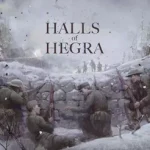
Leave a Reply